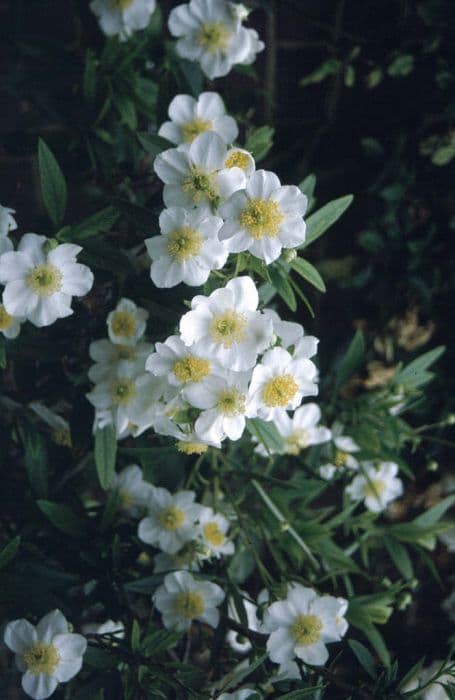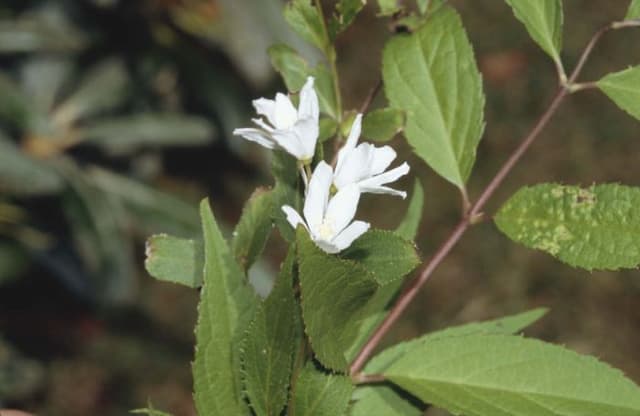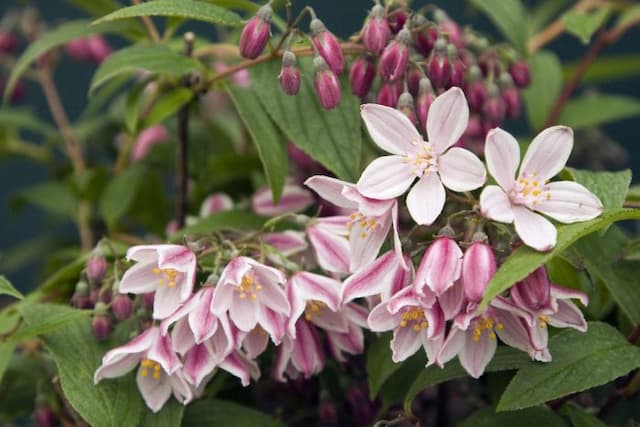Bigleaf Hydrangea Hydrangea macrophylla 'Heinrich Seidel' (H)

ABOUT
The Hydrangea, specifically the 'Heinrich Seidel' variety, is known for its striking and voluminous flower heads that burst into color during its blooming season. These flowers come in a globe-like cluster known commonly as a mophead, due to their lush, rounded shape. The blooms can exhibit a range of colors, often influenced by the soil pH, and may showcase shades of blue, pink, or purple, sometimes with multiple colors appearing on the same plant. Each individual flower is delicate and consists of multiple small florets with a somewhat starry shape. The leaves of the Hydrangea 'Heinrich Seidel' complement the vibrant flowers well. They are large, with a broad, oval shape, coming to a point at the tip, and have serrated edges. These leaves have a deep green color, which provides a lush background for the colorful flowers. The plant's overall shape is bushy, with stout stems that support the weight of the flowers. Throughout the blooming season, this Hydrangea provides a dynamic display as the flowers may change color and mature, providing visual interest. When not in bloom, the plant maintains interest with its substantial foliage and its dense, green presence in the garden.
About this plant
 Names
NamesFamily
Hydrangeaceae
Synonyms
Bigleaf Hydrangea, French Hydrangea, Lacecap Hydrangea, Mophead Hydrangea, Hortensia
Common names
Hydrangea macrophylla 'Heinrich Seidel'.
 Toxicity
ToxicityTo humans
The common name of Hydrangea macrophylla 'Heinrich Seidel' is hydrangea. Hydrangeas are considered to have a low level of toxicity to humans. If ingested, parts of the plant can cause gastrointestinal upset, including vomiting and diarrhea, due to the presence of cyanogenic glycosides, which release hydrogen cyanide when chewed or digested. In rare cases, ingestion can lead to more serious symptoms such as dizziness and confusion.
To pets
The common name of Hydrangea macrophylla 'Heinrich Seidel' is hydrangea. Hydrangeas are toxic to pets such as dogs and cats. Ingestion of any part of the plant can lead to symptoms of poisoning, which may include vomiting, diarrhea, and depression. This toxicity is caused by cyanogenic glycosides found in the plant, which can release hydrogen cyanide in the body. In some cases, ingestion can result in more severe clinical signs including increased heart rate and respiratory rate. If a large amount of plant material is consumed, it could potentially be fatal, although such extreme cases are rare.
 Characteristics
CharacteristicsLife cycle
Perennials
Foliage type
Deciduous
Color of leaves
Green
Flower color
Varies
Height
3-6 feet (0.91-1.83 meters)
Spread
3-6 feet (0.91-1.83 meters)
Plant type
Shrub
Hardiness zones
6
Native area
Japan
Benefits
 General Benefits
General Benefits- Ornamental Value: The Hydrangea macrophylla 'Heinrich Seidel', commonly known as bigleaf hydrangea, provides aesthetic appeal to gardens with its large, colorful blooms.
- Landscape Versatility: This plant can be used in a variety of landscaping designs, including as a stand-alone specimen, in mixed borders, or in container gardens.
- Seasonal Interest: Bigleaf hydrangeas have a long blooming season, often from early summer to late fall, offering extended visual interest in the garden.
- Attracts Pollinators: The showy flowers attract bees and butterflies, which are beneficial for pollination and the overall health of the garden ecosystem.
- Shade Tolerance: Bigleaf hydrangeas can thrive in partial shade, making them suitable for areas of the garden that do not receive full sunlight.
- Variety of Colors: Depending on the soil pH, the flowers can range from blue to pink to purple, allowing gardeners to create a desired color palette.
- Cold-Hardy: Many varieties of Hydrangea macrophylla, including 'Heinrich Seidel', are cold-hardy, allowing them to be grown in cooler climates.
- Easy to Propagate: These plants can be easily propagated from cuttings, making it simple to expand the garden or share with others.
 Medical Properties
Medical Properties- This plant is not used for medical purposes.
 Air-purifying Qualities
Air-purifying QualitiesThis plant is not specifically known for air purifying qualities.
 Other Uses
Other Uses- Adding aluminum sulfate to the soil around hydrangeas can change the color of their blooms to a more vivid blue, making them a tool for garden artistry.
- Hydrangea leaves, when dried, can be used in the creation of natural dyes for fabrics, yielding a range of color depending on the mordant used.
- The bark of the hydrangea plant has been historically used in some cultures for making a type of tea, though it is not a common practice.
- Hydrangea flowers are used in pressed flower crafts due to their wide range of colors and large, intricate blooms.
- Dried hydrangea flower arrangements serve as long-lasting, decorative pieces for homes and events because of their structure.
- Hydrangea petals can be used to create a natural confetti for celebrations that is biodegradable and environmentally friendly.
- Sachets made from dried hydrangea petals can impart subtle scents on linens and clothing when placed in drawers or closets.
- Hydrangea flowers can be utilized in potpourri mixtures, contributing vibrant colors and volume to the mixture.
- Landscape designers often use hydrangeas for their ability to thrive in coastal conditions, where other plants might struggle due to the salty soil.
- The wood of the hydrangea can be used in miniature carving crafts, although it is not a commonly known practice.
Interesting Facts
 Feng Shui
Feng ShuiThe Hydrangea is not used in Feng Shui practice.
 Zodiac Sign Compitability
Zodiac Sign CompitabilityThe Hydrangea is not used in astrology practice.
 Plant Symbolism
Plant Symbolism- Heartfelt Emotions: Hydrangeas, particularly Hydrangea macrophylla, often symbolize deep and heartfelt emotions due to their lush, full heads of petals that can seem to radiate abundance and generosity.
- Gratitude and Apology: Hydrangeas can be given as a symbol of gratitude or as an apology, which may pertain to a Japanese legend that associated the plant with apologies and gratitude.
- Understanding: The wide range of colors and their ability to change hue in relation to the soil acidity can represent an understanding and ability to see different viewpoints.
- Frivolity: Some narratives suggest that hydrangeas symbolize frivoleness, perhaps because of the showy nature of their flowers and their ability to easily change color.
- Boastfulness or Vanity: This comes from the Victorian era, where flowers had specific meanings, and since hydrangeas produce large, beautiful flowers, they were sometimes associated with boastfulness or vanity.
 Water
WaterFor the bigleaf hydrangea, it's best to water deeply once a week, providing about 1 inch of water each time. In hotter and drier conditions, you might need to water twice a week. The soil should be kept moist, but not waterlogged. Relying on rainfall can be sufficient during non-drought conditions, but during prolonged dry periods, you should supplement with additional watering. Use a soaker hose or drip irrigation to deliver water directly to the base of the plant, which will help to minimize leaf wetting and potential fungal issues.
 Light
LightBigleaf hydrangeas prefer partial shade with morning sun and afternoon shade being optimal. Avoid planting in full sun, as it may lead to scorching of the leaves, especially in southern climates. A spot that receives filtered sunlight or light dappled shade under tall trees is also suitable for these hydrangeas.
 Temperature
TemperatureBigleaf hydrangeas thrive best in temperatures between 60°F and 75°F. They can tolerate a minimum temperature of around 50°F but should be protected from frost. In contrast, temperatures above 80°F might stress the plant, particularly if not adequately watered. To ensure optimal growth and flower production, aim to maintain conditions within this temperature range as much as possible.
 Pruning
PruningPruning bigleaf hydrangeas is important to maintain shape, remove dead or diseased wood, and encourage blooming. They should be pruned immediately after flowers fade in late summer, as they bloom on old wood. Remove only spent flowers and dead branches, being careful not to cut off healthy buds, which will form next year's blooms.
 Cleaning
CleaningAs needed
 Soil
SoilBigleaf Hydrangea prefers rich, moist, well-draining soil with a pH of 5.5-6.5. A mix containing peat moss, compost, and perlite or vermiculite can provide the needed structure and nutrition, maintaining slight acidity which is crucial for this hydrangea's health and bloom color.
 Repotting
RepottingBigleaf Hydrangeas typically require repotting every 2-3 years, or when they become root-bound. The best time to do this is in late winter or early spring before the growing season begins.
 Humidity & Misting
Humidity & MistingBigleaf Hydrangeas thrive in environments with high humidity, preferably between 60-70%. Consistent moisture in the surrounding air helps their large leaves stay lush and healthy.
 Suitable locations
Suitable locationsIndoor
Position in bright, indirect light; keep soil moist.
Outdoor
Plant in morning sun and afternoon shade; shelter from harsh winds.
Hardiness zone
6-9 USDA
 Life cycle
Life cycleThe life of the French Hydrangea 'Heinrich Seidel' begins with germination, which occurs when the seed is planted in moist, well-drained soil in a location with partial sunlight. Following germination, the seedling stage involves the development of roots and shoots, and it takes a few weeks before true leaves start to emerge. The vegetative growth stage is marked by the formation of a strong root system, stems, and foliage, with the plant growing actively during the spring and summer. Flowering typically occurs in early summer to late fall, with the plant producing large, showy flower heads that are a blend of sterile and fertile flowers. After pollination and seed setting, which might not be significant for cultivated varieties like this one, the plant enters a period of dormancy during the winter, where growth slows down and the plant conserves energy. The following spring, the cycle resumes, with new growth emerging from the crown and any surviving branches, and the plant continues to mature and eventually reaches a stage where it can be divided or propagated through cuttings to produce new plants.
 Propogation
PropogationPropogation time
Spring-Early Summer
The most popular method of propagating the Hydrangea macrophylla 'Heinrich Seidel', commonly known as Bigleaf Hydrangea, is through softwood cuttings. This process is ideally carried out in late spring to early summer when the plant's new growth is mature enough yet still tender. To propagate, you would cut a 4 to 6-inch (10 to 15 cm) long stem with several leaves, making the cut just below a leaf node. The lower leaves are removed, and the cut end is dipped into a rooting hormone to enhance root development. The stem is then planted in a moist potting mix, ensuring at least one set of leaf nodes is below the surface. The cutting is typically kept in a warm, humid environment under indirect light until roots have established, which usually takes several weeks. After roots have formed, the young hydrangea can be gradually acclimated to outdoor conditions and then transplanted into the garden.








![Hydrangea [Strong Annabelle]](/_next/image?url=https%3A%2F%2Fplants-admin.emdemapps.com%2Fimages%2Fplants%2F%2Fimages%2F604b54db37d34.png&w=640&q=75)
